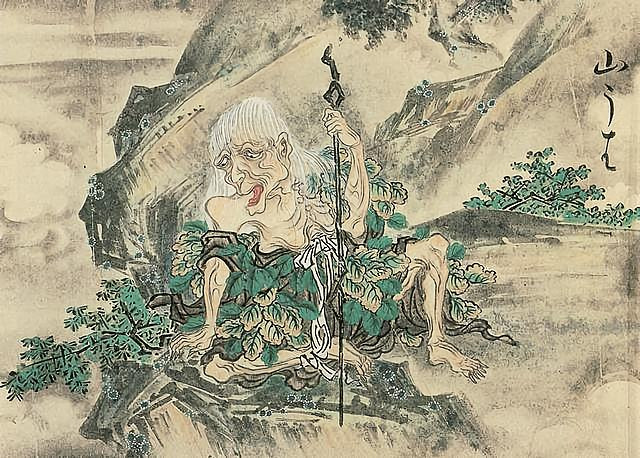
The 10 Most Terrifying Ghosts in Asian Cultures
Think hungry ghosts are the only specters in Chinese culture? Think again! Spooky spirits run amok not just in Chinese but many Asian cultures — and some of them scare the bejeezus out of us. Here are 10 of the most terrifying ghosts from Asian countries.
Shui Gui, the Drowned Ghost

A panel from "Strange Ghosts" by Pu Ru
Just when you thought it was safe to go back into the water. Translated from Chinese as “water ghost,” shui gui are the spirits of people who have drowned and whose bodies were never recovered or given a proper burial. They lurk near where they died, waiting to pull in another victim. Only then will they be free to move on while the new shui gui takes its place.
Nu Gui, the Avenging Ghost
This Chinese spirit is pissed and she doesn’t care who knows it. Having been wronged, abused, or even murdered in life, she spends her death seeking revenge. Like the western succubus , she sucks at the hun or yang essence from men, eventually killing them.
Jiangshi, the Hopping Vampire
 Still from movie "Mr. Vampire"
Still from movie "Mr. Vampire"
According to Chinese myth, a corpse might reanimate for a few different reasons: a violent death, an improper burial (we’re sensing a theme here), being struck by lightning (Frankenstein anyone?), or being hopped over by an animal, especially cats (cue shrug). Regardless of how it got that way, jiangshi, which means “stiff corpse,” can only move by hopping, and maintains its undead self by sucking the qi or life force out of living humans.
The jiangshi is the subject of many movies, including hit Hong Kong horror-comedy series, Mr. Vampire.
Yuki-onna, the Snow Woman
 "Yuki-onna" from the Hyakkai-Zukan by Sawaki Suushi
"Yuki-onna" from the Hyakkai-Zukan by Sawaki Suushi
With a head-to-toe snow-white ensemble and long black hair, the Japanese Yuki-onna is the stuff of nippy nightmares. She drifts rather than walks, leaving no footprints in the snow behind her. To freeze her victims to death, she simply blows her icy cold breath on them, after which she sucks out their souls.
You can see a depiction of Yuki-onna in legendary filmmaker Akira Kurosawa’s Dreams.
Yamauba, the Mountain Witch

"Yama-uba" from the Hyakkai-Zukan by Sawaki Suushi
Going on a hike? Don’t talk to any weird old women! The Japanese yamauba is said to have started out as human but was forced to live in the mountains after being ostracized by her family, and somewhere along the way, took up the habit of cannibalism. Myth says she has an additional mouth on top of her head hidden by hair. All the better to eat you with.
Manananggal, the Body-Separating Vampire
Filipino myth has some gnarly creatures of the night. A kind of aswang or vampire shapeshifter, the manananggal not only feasts on pregnant women and their unborn babies, it separates its torso from its lower body in order to fly around — dangling intestines and all.
Tiyanak, the Baby Vampire
If you ever hear baby crying in the middle of a dark wood, that baby may need help. Or it might be a vampire. (Tomato, tomahto.) This type of aswang is said to be the spirits of children whose mothers died in childbirth or those who passed before being baptized.
Phi Pop, the Cannibal Ghost
Not only does this hungry ghost from Thai culture eat human and animal flesh, it can do so from the inside out. Its method is to possess the poor creature, then feast on its organs. A couple of years ago, there were reports of a phi pop haunting a small village in Thailand what with the inexplicable deaths of four cows and the illnesses of four police officers.
Phi Lang Kluang, the Ghost with the Gaping Wound
Scratch my back and — YIKES! If you’re chilling outdoors one night in southern Thailand and a random stranger joins your group and asks for someone to scratch his back, just don’t. It might be a phi lang kluang, a ghost who looks normal until he reveals the gaping, festering wound on his back, so wide his entrails, teeming with maggots, worms, and other squirmies, are visible.
Krasue, the Floating Vampire Head

Poster for Thai movie, "Krasue Valentine"
Similar to the Manananggal, the krasue feeds on blood and flesh, but according to Thai myth, the reason is a curse. As punishment for sins in life, the unfortunate woman is struck forever hungry in the afterlife. During the day she disguises herself as a normal human, but at night she separates her head from her body and floats around looking for victims. And like the Manananggal, her organs are out for all to see. You can see imaginings of the krasue in many movies, including “romantic horror” Krasue Valentine.
Want even more creature features? Check out our posts on the Hungry Ghost Festival and Asian solar and lunar eclipse myths.
